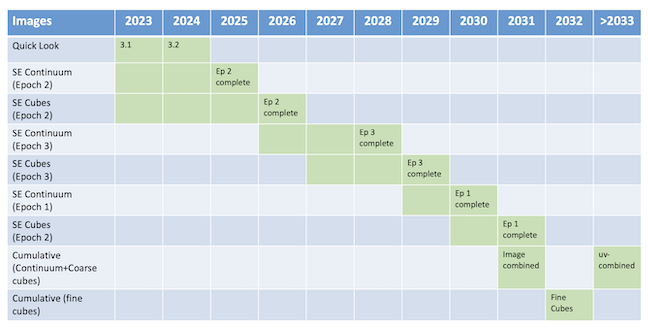Basic Data Products
Basic Data Products
The VLASS Basic Data Products (BDPs) consist of:
- Raw visibility data (available from the NRAO archive under the campaign project code, e.g. VLASS1.1, VLASS1.2, VLASS2.1 etc, or just type these into the search box at the top.)
- Calibration products (also available from the NRAO archive). Calibrated measurement sets can be restored using these instructions. Note that some VLASS1.1 calibrations will fail to restore due to an error in the flag versions file. Please file a Helpdesk ticket if you run across this issue.
- Quick Look continuum images (access here). Note that images are also available from the NRAO archive, but the Epoch 1 images in the NRAO archive have not been updated to include position corrections, so its use is not recommended.
- Single epoch continuum images (including in-band spectral index information) and coarse (128 MHz channel width) image cubes in Stokes I, Q, U.
Access SE continuum images here (Users Guide here)
Access demonstration SE polarization cube images here (Users Guide here)
- Single Epoch component catalogs (at CIRADA (link))
- Cumulative VLASS continuum images, and cubes with both coarse and fine (16 MHz) sampling in frequency (the fine cubes will only cover bright regions of emission) (to be made).
- Cumulative VLASS component catalogs (to be made).
Naming
VLASS data products are labelled by epoch and/or observing campaign (except for the cumulative products). VLASS observing campaigns are scheduled 16 months apart (every time B-configuration is available) and cover half of the sky each, so two campaigns comprise a single epoch. The naming convention is VLASS<epoch>.1 or .2, depending on which half of the sky is covered. For example, VLASS1.1 corresponds to the first half of the first epoch and VLASS1.2 to the second half of the first epoch. Every effort is made to ensure that the sky coverage in each of the halves of the epochs is consistent, so, for example, VLASS2.2 will observe the same part of the sky as VLASS1.2.
Pipelines
The pipeline versions used for the various data products are listed here. See this page for instructions on running the VLASS pipelines outside of NRAO.
Data availability and schedule
The raw visibility data are available immediately after observation from the NRAO archive by searching for programs VLASS1.1, VLASS1.2 etc, and calibration products are also stored there as soon as they are made. The calibration and Quick Look image products are produced as soon as possible (~2-4 weeks) after observations. Due to algorithmic difficulties and compute needs, combined with the need for more careful quality assurance, the Single Epoch and cumulative image products have been delayed, but are now starting to be made available. The estimated schedule is shown below.
The VLASS pipeline recipes may be found in recent joint releases of CASA and the pipeline. The recipes run are hifvcalvlass_compression (or hifvcalvlass if no gain compression fix is required) and vlassQLIP. Note that VLASS processing sometimes uses non-standard releases. The complete list of pipeline versions used for VLASS is given in this table.
The VLASS Quick Look images are produced using simplified algorithms that result in some compromises in accuracy, and no self-calibration is applied. In addition, the first epoch of VLASS was affected by problems with the online system. These resulted in ghost images, and the first half of the Epoch 1 data (VLASS1.1) has relatively poor flux density accuracy. These issues are described in detail in VLASS Memo 13.
Single Epoch component lists will list source components identified by the source-finding software (pyBDSF). Combination of source components into physical sources will be performed by CIRADA as part of the effort to create enhanced data products.
Should I use Quick Look images for my (non-transient) science, or wait for the Single Epoch continuum products?
The limitations of the Quick Look images are mostly related to dynamic range. The Single Epoch images have significantly better dynamic range within a few beams of a bright source (by about a factor of two), and better peak flux densities (due to self-calibration), but are otherwise similar to Quick Look. Quick Look products do not include spectral index information, however, whereas in-band spectral indices (reliable for compact sources) are available as a Single Epoch product. Therefore, users who care about source morphology in high contrast (>~20:1 dynamic range) situations and/or need spectral index information should use Single Epoch products. In all other respects, however, (flux density calibration, positional accuracy, noise etc) the Quick Look images are comparable to Single Epoch and can be used without needing to wait for the Single Epoch products. Note, though, that VLASS1.1 Quick Look images have issues with antenna pointing errors resulting in poor calibration, so VLASS2.1 and 3.1 Quick Look images are to be preferred to VLASS1.1.
Data Volume
| Data Product | Per Epoch (TB) | Total (TB) |
|---|---|---|
| Raw visibilities | 170 | 510 |
| Quick Look | 4 | 12 |
| Single Epoch* | 400 | 1200 |
| Cumulative* | - | 500 |
| Total | 574 | 2222 |
* - assumes coarse cubes will be made for the whole sky.





Connect with NRAO